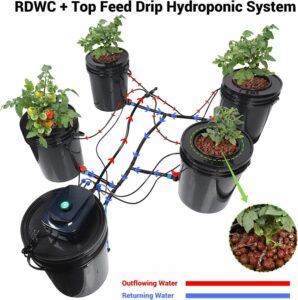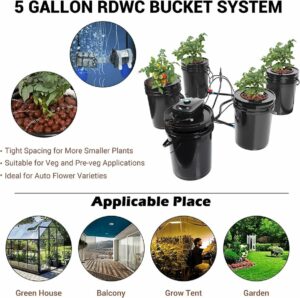Hydroponic Gardening on a Budget: Creating a Thriving 5-Gallon Bucket Drip System
Introduction
Hydroponic gardening has recently gained popularity as a sustainable and efficient method of cultivating plants.
By providing essential nutrients directly to the plant’s roots in a water-based solution, hydroponics eliminates the need for soil while maximizing crop yield.
While hydroponics systems can vary in complexity and cost, this article will focus on a budget-friendly approach: creating a thriving 5-gallon bucket drip system.
This system offers affordability, versatility, and the potential for excellent results.
Provo Green Products is your reliable source for discovering sustainable products that positively impact your life and the environment.
With extensive experience in manufacturing, trades, and construction, Provo Green Products thoroughly researches each product before providing accurate and up-to-date information on its sustainability.
You can trust that you’re getting trustworthy insights to make informed choices whether you’re looking for solar products, electric bikes, eco-friendly products, renewable energy solutions, etc.
Provo Green Products is your go-to destination for finding the right green products for your lifestyle.
Disclosure: We may earn a small commission if you click on one of our links.
This does not affect the pricing of the product whatsoever.
Understanding Hydroponic Gardening
Before delving into the specifics of the 5-gallon bucket drip system, it’s essential to grasp the fundamentals of hydroponic gardening.
Unlike traditional soil-based methods, hydroponics relies on a nutrient-rich solution to deliver the necessary minerals directly to the plant roots.
This targeted approach provides plants optimal nutrition and eliminates the risks associated with soil-borne diseases and pests.
One of the critical advantages of hydroponics is its potential for higher yields in a smaller space.
By removing the reliance on soil, plants can focus their energy on growth and development, resulting in faster growth rates and increased productivity.
Additionally, hydroponics conserves water by recirculating the nutrient solution, making it an environmentally friendly option.

Benefits of a 5-Gallon Bucket Drip System
The 5-gallon bucket drip system offers several benefits, especially for those on a budget. First and foremost, the system is highly cost-effective.
The materials for a basic 5-gallon bucket drip system are relatively inexpensive and readily available.
This makes it an accessible option for beginners or anyone exploring hydroponics without a significant financial investment.
Another advantage of the 5-gallon bucket drip system is its versatility.
The system can be scaled up or down based on the available space and desired plant capacity.
This flexibility suits small gardens, balconies, or indoor spaces.
Whether you have a limited area or an expansive setup, the 5-gallon bucket drip system can be tailored to meet your needs.
A drip irrigation system delivers water and nutrients directly to the plant roots, minimizing waste and optimizing nutrient uptake.
This targeted approach ensures that plants receive the necessary resources while reducing the risk of overwatering or nutrient runoff.
Furthermore, the 5-gallon bucket drip system is highly efficient regarding water and nutrient usage.
Building Your 5-Gallon Bucket Drip System
To create a 5-gallon bucket drip system, you’ll need a few essential materials and tools.
Begin by gathering the following items:
- Five-gallon buckets: Ensure they are clean and have no chemical residues.
- Lid for each bucket: This will hold the plants and prevent light from reaching the nutrient solution.
- Drip irrigation system: Consisting of a pump, tubing, and emitters, this component will distribute the nutrient solution to the plants.
- Air pump (optional): Adding an air pump to the system can provide oxygenation to the nutrient solution, benefiting the plant roots.
- Growing medium: Choose a suitable medium like coconut coir, perlite, or vermiculite, which will support the plant roots and retain moisture.
- Nutrient solution: Select a hydroponic nutrient solution appropriate for the plants you plan to grow.
Once you have gathered the necessary materials, you can assemble your 5-gallon bucket drip system.
Follow these step-by-step guidelines:
- Prepare the buckets: Drill holes in the bottom of each bucket for drainage. These holes will prevent waterlogging and ensure adequate oxygen supply to the roots.
- Create the drip irrigation system: Attach the tubing to the pump and run it through the holes in the bucket lids. Position the emitters at the top of each lid, ensuring that they are evenly spaced to provide uniform watering to the plants.
- Set up the nutrient reservoir: Place a larger container or a separate bucket to act as the nutrient reservoir. Connect the pump tubing to the reservoir, allowing the solution to be pumped up and distributed through the drip system. Ensure the reservoir is placed lower than the buckets to enable gravity-fed irrigation.

Choosing the Right-Growing Medium
Selecting the appropriate growing medium is crucial for the success of your 5-gallon bucket drip system.
The growing medium serves as a support structure for the plant roots and retains moisture, ensuring they have access to water and nutrients.
Commonly used growing mediums include coconut coir, perlite, vermiculite, and a combination of these materials.
Consider water retention, aeration, and pH neutrality when choosing a growing medium.
Experiment with combinations to find the right balance for your plants’ needs.
Coconut coir is an excellent choice as it retains moisture well and provides good aeration to the roots.
Perlite and vermiculite offer lightweight and porous options that aid in water drainage and root oxygenation.
Nutrient Solution and pH Management
Providing a well-balanced nutrient solution is crucial to ensure your plants’ optimal growth and health.
Hydroponic nutrient solutions contain a combination of essential macro and micronutrients that plants require for their growth stages.
These solutions are available in pre-mixed formulas or as separate nutrient components that must be mixed according to specific ratios.
Regularly monitor the pH level of your nutrient solution using a pH meter or test strips.
The ideal pH range for most plants in a hydroponic system is between 5.5 and 6.5. pH levels outside of this range can affect nutrient availability and lead to nutrient deficiencies or toxicities.
Adjust the pH by adding pH-up or pH-down solutions to maintain the desired range for optimal plant nutrient uptake.
Plant Selection and Care
When choosing plants for your 5-gallon bucket drip system, consider their growth habits, size, and nutrient requirements.
Leafy greens such as lettuce, kale, and spinach, as well as herbs like basil and cilantro, are famous for hydroponic gardening.
Compact fruiting plants like cherry tomatoes and peppers can also thrive in this system.
Planting in the 5-gallon bucket drip system is relatively straightforward.
Fill each bucket with the chosen growing medium and create a small hole or indentation to place the seedling or transplant.
Gently firm the medium around the roots, ensuring they have contact with the growing medium.
Water the plant thoroughly after planting, allowing the drip system to take over subsequent watering.
Maintaining optimal environmental conditions is essential for plant health and productivity.
Ensure the growing area receives adequate light through natural sunlight or artificial grow lights.
Monitor the temperature and humidity levels, aiming for a temperature range between 65-75°F (18-24°C) and humidity around 50-60% for most plants.

Troubleshooting Common Issues
Even with careful planning and maintenance, hydroponic systems may encounter specific issues.
Two common problems are nutrient deficiencies and pest infestations.
Nutrient deficiencies can manifest through yellowing leaves, stunted growth, or poor fruit development.
Monitor the nutrient solution’s pH and concentration regularly, making adjustments as necessary.
Pests such as aphids, whiteflies, and spider mites can harm plants.
Implement preventive measures like maintaining a clean and sterile growing environment, regularly inspecting plants for signs of infestation, and introducing beneficial insects like ladybugs or using organic pest control methods.
Additionally, ensure your system functions properly by regularly checking for clogs or leaks in the drip irrigation system.
Clean the system periodically to remove any buildup of algae or mineral deposits that can obstruct the flow of water and nutrients.
Maintaining a well-maintained and functioning technique will help prevent common malfunctions and keep your plants thriving.
Harvesting and Yield Optimization
One of the most rewarding aspects of hydroponic gardening is enjoying a bountiful harvest.
As your plants mature, monitor them closely for signs of readiness for harvest.
Leafy greens can be harvested by removing the outer leaves while allowing the inner leaves to grow.
Fruit-bearing plants like tomatoes or peppers should be harvested when the fruits have reached their desired size and color.
To maximize your yield, consider implementing specific techniques.
Pruning and training plants can help manage their growth and direct energy to productive areas.
Removing dead leaves or excessive foliage improves airflow and prevents the spread of diseases.
Pollination may be necessary for fruiting plants, so gently shake the plants or use a small brush to transfer pollen between flowers.
After harvesting, take the time to clean and sanitize your buckets, lids, and any other system-reusable components.
Proper cleaning removes any potential pathogens or contaminants, reducing the risk of diseases in subsequent crops.
Conclusion
Hydroponic gardening offers an exciting and efficient way to cultivate plants, and it doesn’t have to break the bank.
Utilizing a 5-gallon bucket drip system can create a thriving hydroponic setup on a budget.
This versatile and cost-effective system provides the benefits of hydroponics while being accessible to beginners and those with limited space or resources.
Following the steps outlined in this article, you can build your 5-gallon bucket drip system, choose the right growing medium, and manage the nutrient solution and pH levels effectively.
Selecting suitable plants, providing proper care, and monitoring environmental conditions will ensure healthy growth and productive yields.
Remember to troubleshoot common issues promptly and take preventive measures to maintain the system’s functionality and prevent pest infestations.
With patience, dedication, and a little experimentation, you can enjoy the satisfaction of harvesting your homegrown, nutrient-rich produce year-round.
Embark on your hydroponic gardening journey and witness firsthand the benefits of this budget-friendly approach through the creation of your thriving 5-gallon bucket drip system.
Stay in Touch!
I’am a dedicated entrepreneur with many years of experience and an integrity-driven individual who is highly motivated to succeed. Leveraging extensive expertise in manufacturing, construction, and various trades, we can provide a solid foundation for sustainable living. Our meticulous research process guarantees that our information about each product is precise and current, allowing you to make informed decisions. A deep understanding of business operations empowers me to consistently implement improvements that result in ongoing success. Visit site.
